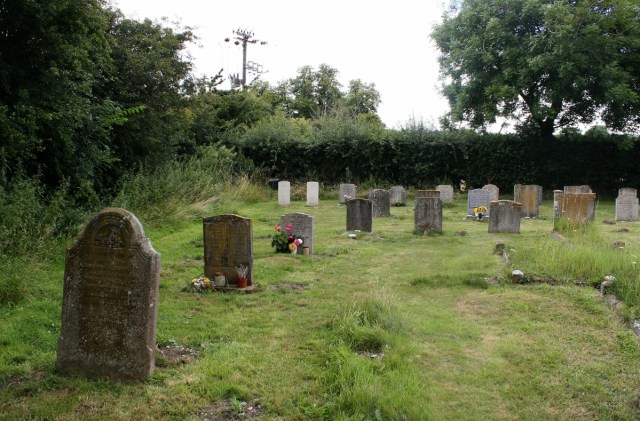As we wander up the pathway,…
…I spy a CWGC headstone on our left,…
…amongst an interesting-looking group of headstones. And apart, with respect, from the smallest, on the right, indeed they are.
This is the grave of Sergeant Albert Clouting, a Royal Air Force Volunteer Reserve pilot who was killed, along with his four-man crew, on the evening of 16th December 1942 when their Wellington bomber crashed near Didcot in Oxfordshire at the start of a night exercise. He was only twenty.
And this is the grave of Private Stanley Jonathan Cracknell, just eighteen when he died, of either sickness or wounds, on 8th April 1918. Curiously, only on his headstone is his regiment given as the Royal Fusiliers,…
…his accompanying documentation all listing him as Middlesex Regiment. Perhaps his brother, a sergeant in the Suffolk Regiment who, as you saw, was responsible for his headstone, got it wrong.
We shall never know, as his brother now lies alongside, having survived him by just two and a half years. If you read his epitaph (click to enlarge), he was, I suspect, wounded at some point in 1918, after the death of his younger brother, and those wounds killed him almost two years later. Supposition, I admit, but logical, surely?
Captain Douglas W. A. Nicholls M.C., Suffolk Regiment, killed in France on 10th April 1917 aged 21,…
…and Private William Tovell, Suffolk Regiment, who died on 22nd April 1915, also aged 21.
The grave of Francis John Sprunt, who died in 1979 at the age of 89. I wonder if, in his latter days, his friends and neighbours knew about the old man next door’s Great War exploits. You will have noticed the D.C.M. after his name on the headstone. Francis Sprunt was a lance sergeant in the Suffolk Regiment at the time, and here, dated 25th November 1916, is his citation; ‘For conspicuous gallantry in action. Single-handed he attacked and killed seven of the enemy. He has on many previous occasions displayed great courage and devotion to duty’.
In the corner of the churchyard,…
…stand two headstones marking the graves of two unnamed sailors of the Merchant Navy whose bodies were presumably washed up along the North Sea coastline, only a couple of miles east of here, during the Second World War.
Unlike most CWGC headstones, these specify that the date given is the date of burial, not death.
For obvious reasons.
From here you can see that this 14th Century church has a thatched roof, something you don’t see too often.
Wandering these churchyards, there are times when you have to look at the headstone inscriptions very closely,…
…and on this occasion, beneath the name of William Buck, who died in March 1918 aged 84, it says ‘A Crimean veteran of the R.H.A.’.
Also remembered on this headstone, at the bottom, is thirty three year-old Skipper Leonard Brown, Royal Naval Reserve, who died aboard H.M. Trawler, Silver Queen, during an engagement on 15th* February 1918 in the Straits of Dover which saw eight British ships sunk. Should you wish to learn more, click here.
*the headstone inscription says 14th, but is a day out.
Brown, along with many other naval (and other) casualties from both world wars, is buried in Dover (St. James’s) Cemetery, which is not a military cemetery, but does now contain eight hundred or so military burials (and includes a ‘Dunkirk Plot’) alongside those of the local civilian population.






















Interesting the burials you find in local churchyards/cemeteries when you stop to read the inscriptions. Sad for Mrs Cracknell had already lost her husband at some point and then her two sons within a few years so many stories. Sadly with the increasing numbers now being cremated so much of that history will be lost.
Thank you M for this post, I do love a wander round a churchyard
Hey ho M! Good point, that. I did do a Surrey churchyard wander in September with a friend – four churchyards & a war memorial – pics to come – but haven’t since.
Really interesting – and some good insight. Thanks for posting
It often amazes me how much one can find out – although I must say that having the five-volume Great War D.C.M. citation list helped here a bit! Thank you Michael.
A very interesting little wander M. Amazing what you can find in these cemeteries sometimes. And there can’t be more than a handful of thatched churches left in the uk, very nice to see
It was indeed. And really nice to see a thatched church. I am currently battling with a cemetery I visited a couple of months ago where I found over 30 Great War burials – and have since discovered I should have found 55!! Luckily it is not so far away……..
i am trying to trace where my great great grandparents were buried early 1900’s.
He was Henry Andrews died 1907 and his wife Ann died 1905. Henry lived at The Mills and was a very dedicated member of his church in kelsale and I have not been able to find where he may be buried and was wondering if you can throw any light on him I feel that as such a strong member of his church there should be some trace of him. He was a Sunday School teacher and conducted prayer meetings. Any help would be so appreciated as we are in Australia and find it difficult to trace family members thankyou
I really can’t help as I was just passing through when I took these photos. There must be a local historical society in the Kelsale area that would be happy to help you. And email the church.